MITSUBISHI iMiEV 2015 Owner's Manual (in English)
Manufacturer: MITSUBISHI, Model Year: 2015, Model line: iMiEV, Model: MITSUBISHI iMiEV 2015Pages: 262, PDF Size: 26.84 MB
Page 211 of 262
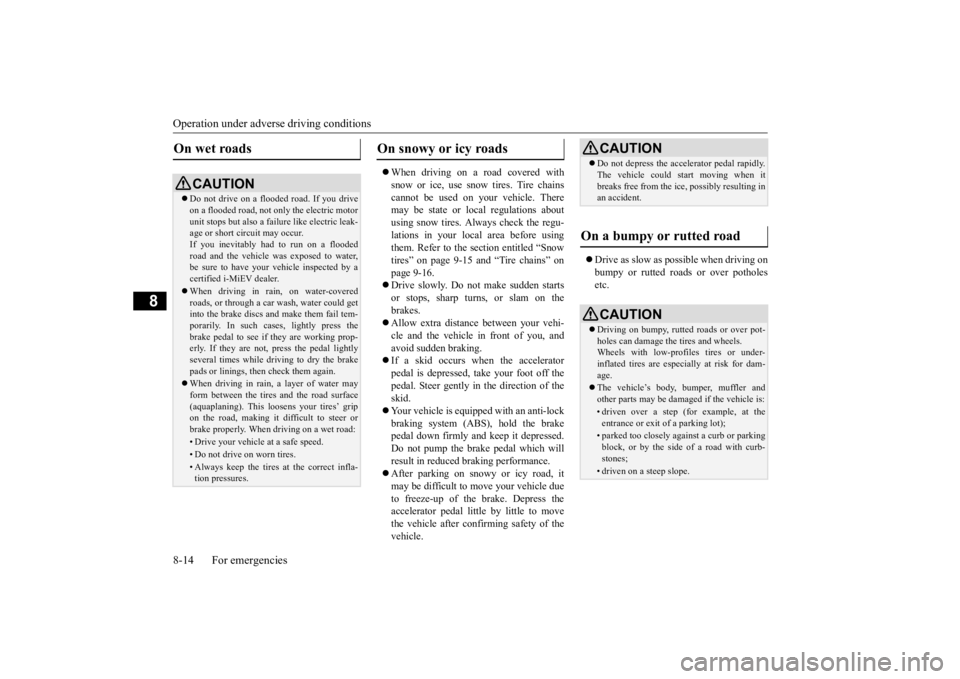
Operation under adverse driving conditions 8-14 For emergencies
8
When driving on a road covered with snow or ice, use snow tires. Tire chains cannot be used on your vehicle. There may be state or local regulations aboutusing snow tires. Always check the regu- lations in your local area before using them. Refer to the section entitled “Snowtires” on page 9-15 and “Tire chains” on page 9-16. Drive slowly. Do not make sudden starts or stops, sharp turns, or slam on the brakes. Allow extra distance
between your vehi-
cle and the vehicle in front of you, and avoid sudden braking. If a skid occurs when the accelerator pedal is depressed, take your foot off the pedal. Steer gently in the direction of theskid. Your vehicle is equippe
d with an anti-lock
braking system (ABS), hold the brakepedal down firmly and
keep it depressed.
Do not pump the brake pedal which will result in reduced braking performance. After parking on snowy or icy road, it may be difficult to move your vehicle due to freeze-up of the brake. Depress theaccelerator pedal little by little to move the vehicle after confirming safety of the vehicle.
Drive as slow as possible when driving on bumpy or rutted roads or over potholesetc.
On wet roads
CAUTION Do not drive on a flooded road. If you drive on a flooded road, not only the electric motorunit stops but also a fail
ure like electric leak-
age or short circuit may occur. If you inevitably had to run on a floodedroad and the vehicle was exposed to water, be sure to have your vehicle inspected by a certified i-MiEV dealer. When driving in rain, on water-covered roads, or through a car wash, water could getinto the brake discs and make them fail tem- porarily. In such cases, lightly press the brake pedal to see if they are working prop-erly. If they are not, press the pedal lightly several times while driving to dry the brake pads or linings, then check them again. When driving in rain, a layer of water may form between the tires and the road surface(aquaplaning). This l
oosens your tires’ grip
on the road, making it difficult to steer or brake properly. When driving on a wet road:• Drive your vehicle at a safe speed.• Do not drive on worn tires.• Always keep the tires at the correct infla-tion pressures.
On snowy or icy roads
CAUTION Do not depress the acce
lerator pedal rapidly.
The vehicle could start moving when itbreaks free from the ice, possibly resulting inan accident.
On a bumpy or rutted road
CAUTION Driving on bumpy, rutted roads or over pot- holes can damage the tires and wheels. Wheels with low-profiles tires or under- inflated tires are especially at risk for dam-age. The vehicle’s body, bumper, muffler and other parts may be dama
ged if the vehicle is:
• driven over a step (for example, at the entrance or exit of a parking lot);• parked too closely against a curb or parkingblock, or by the side of a road with curb-stones;• driven on a steep slope.
BK0209800US.book 14 ページ 2014年1月14日 火曜日 午前9時26分
Page 212 of 262
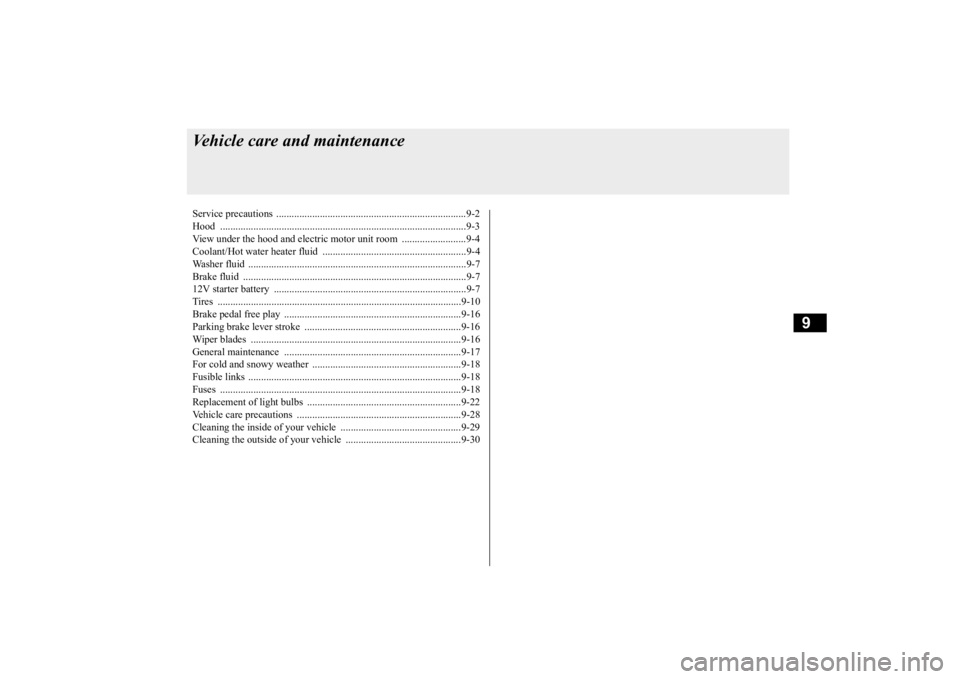
9
Vehicle care and maintenanceService precautions ..........................................................................9-2 Hood .............
............
...........
...........
...........
...........
...........
...........
.....9-3
View under the hood and electric motor unit room .........................9-4Coolant/Hot water heater fluid ........................................................9-4 Washer fluid .....................................................................................9-7 Brake fluid .......................................................................................9-712V starter battery ...........................................................................9-7 Tires ...............................................................................................9-10 Brake pedal free play .....................................................................9-16Parking brake lever stroke .............................................................9-16 Wiper blades ..................................................................................9-16 General maintenance .....................................................................9-17For cold and snowy weather ..........................................................9-18 Fusible links ...................................................................................9-18 Fuses ..............................................................................................9-18Replacement of light bulbs ............................................................9-22 Vehicle care precautions ................................................................9-28 Cleaning the inside of your vehicle .......
...........
...........
...........
.......9-29
Cleaning the outside of your vehicle .....
...........
...........
...........
.......9-30
BK0209800US.book 1 ページ 2014年1月14日 火曜日 午前9時26分
Page 213 of 262
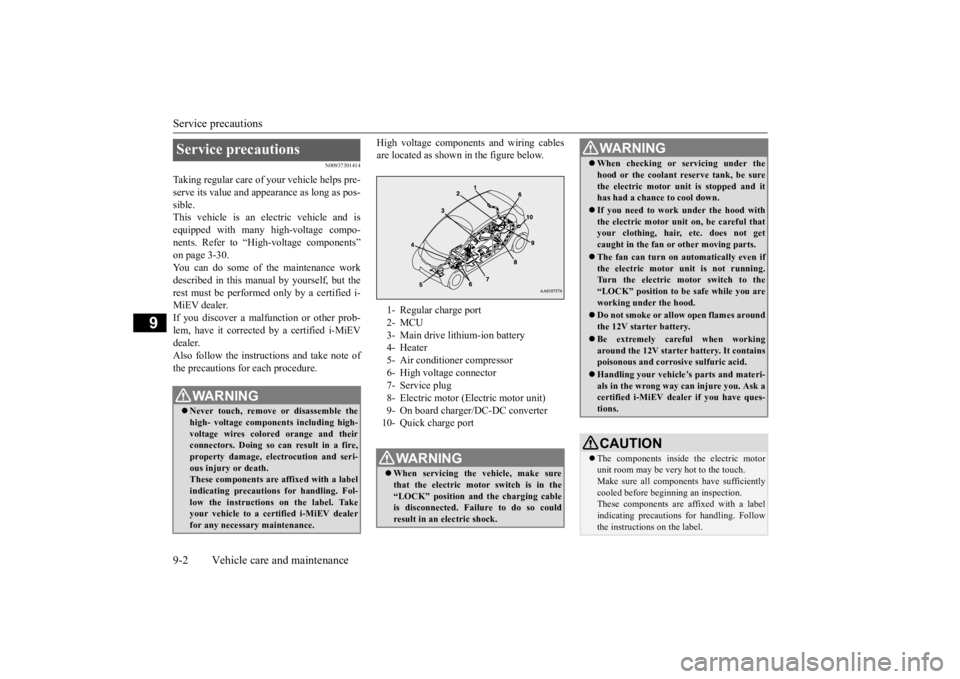
Service precautions 9-2 Vehicle care and maintenance
9
N00937301414
Taking regular care of your vehicle helps pre- serve its value and appe
arance as long as pos-
sible.This vehicle is an electric vehicle and is equipped with many high-voltage compo- nents. Refer to “High-voltage components”on page 3-30. You can do some of the maintenance work described in this manual by yourself, but the rest must be performed
only by a certified i-
MiEV dealer.If you discover a malfunction or other prob- lem, have it corrected by a certified i-MiEV dealer.Also follow the instru
ctions and take note of
the precautions for each procedure.
High voltage components and wiring cables are located as shown in the figure below.
Service precautions
WA R N I N G Never touch, remove or disassemble the high- voltage componen
ts including high-
voltage wires colore
d orange and their
connectors. Doing so can result in a fire, property damage, elec
trocution and seri-
ous injury or death. These components are affixed with a label indicating precautions for handling. Fol-low the instructions on the label. Take your vehicle to a cert
ified i-MiEV dealer
for any necessary maintenance.
1- Regular charge port 2- MCU 3- Main drive lithium-ion battery4- Heater 5- Air conditioner compressor 6- High voltage connector7- Service plug 8- Electric motor (Electric motor unit) 9- On board charger/DC-DC converter10- Quick charge port
WA R N I N G When servicing the vehicle, make sure that the electric motor switch is in the“LOCK” position and
the charging cable
is disconnected. Failure to do so could result in an electric shock.
When checking or servicing under the hood or the coolant reserve tank, be surethe electric motor unit is stopped and ithas had a chance to cool down. If you need to work
under the hood with
the electric motor unit on, be careful that your clothing, hair, etc. does not get caught in the fan or other moving parts. The fan can turn on automatically even if the electric motor unit is not running.Turn the electric motor switch to the “LOCK” position to be
safe while you are
working under the hood. Do not smoke or allow open flames around the 12V starter battery. Be extremely careful when working around the 12V starter battery. It containspoisonous and corros
ive sulfuric acid.
Handling your vehicle’s parts and materi- als in the wrong way can injure you. Ask a certified i-MiEV dealer
if you have ques-
tions. CAUTION The components inside
the electric motor
unit room may be very
hot to the touch.
Make sure all components have sufficientlycooled before beginning an inspection. These components are affixed with a label indicating precautions
for handling. Follow
the instructions on the label.WA R N I N G
BK0209800US.book 2 ページ 2014年1月14日 火曜日 午前9時26分
Page 214 of 262
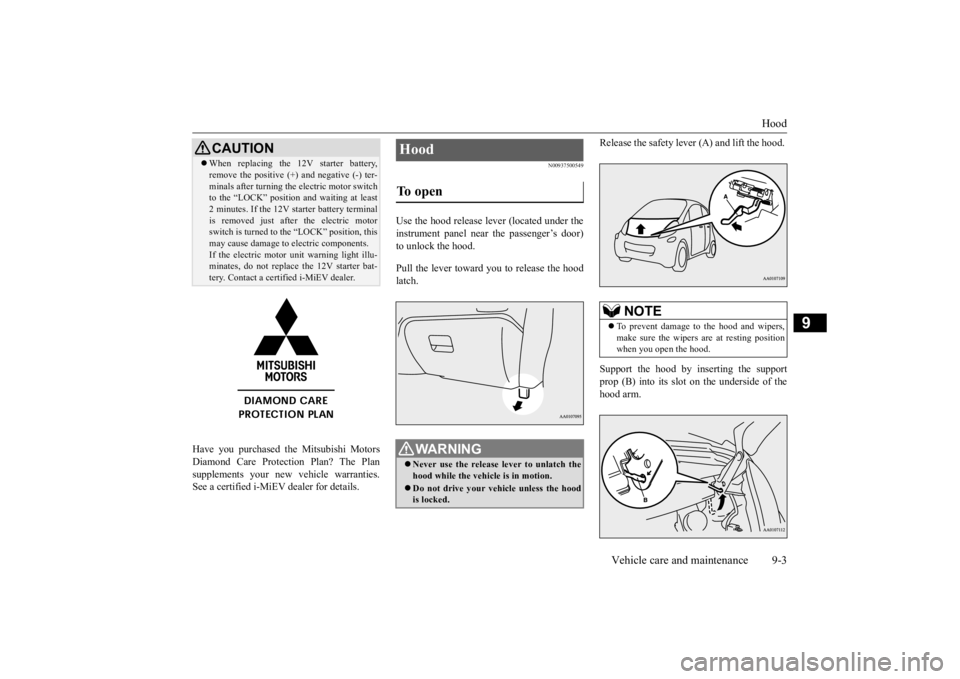
Hood
Vehicle care and maintenance 9-3
9
Have you purchased the Mitsubishi Motors Diamond Care Protec
tion Plan? The Plan
supplements your new
vehicle warranties.
See a certified i-MiEV dealer for details.
N00937500549
Use the hood release lever (located under the instrument panel near the passenger’s door) to unlock the hood. Pull the lever toward you to release the hood latch.
Release the safety leve
r (A) and lift the hood.
Support the hood by inserting the support prop (B) into its slot on the underside of the hood arm.
When replacing the
12V starter battery,
remove the positive (+
) and negative (-) ter-
minals after turning the electric motor switchto the “LOCK” position
and waiting at least
2 minutes. If the 12V st
arter battery terminal
is removed just after the electric motorswitch is turned to the “LOCK” position, this may cause damage to
electric components.
If the electric motor unit warning light illu-minates, do not replac
e the 12V starter bat-
tery. Contact a certified i-MiEV dealer.CAUTION
Hood To open
WA R N I N G Never use the release lever to unlatch the hood while the vehicle is in motion. Do not drive your vehicle unless the hood is locked.
NOTE
To prevent damage to the hood and wipers, make sure the wipers
are at resting position
when you open the hood.
BK0209800US.book 3 ページ 2014年1月14日 火曜日 午前9時26分
Page 215 of 262
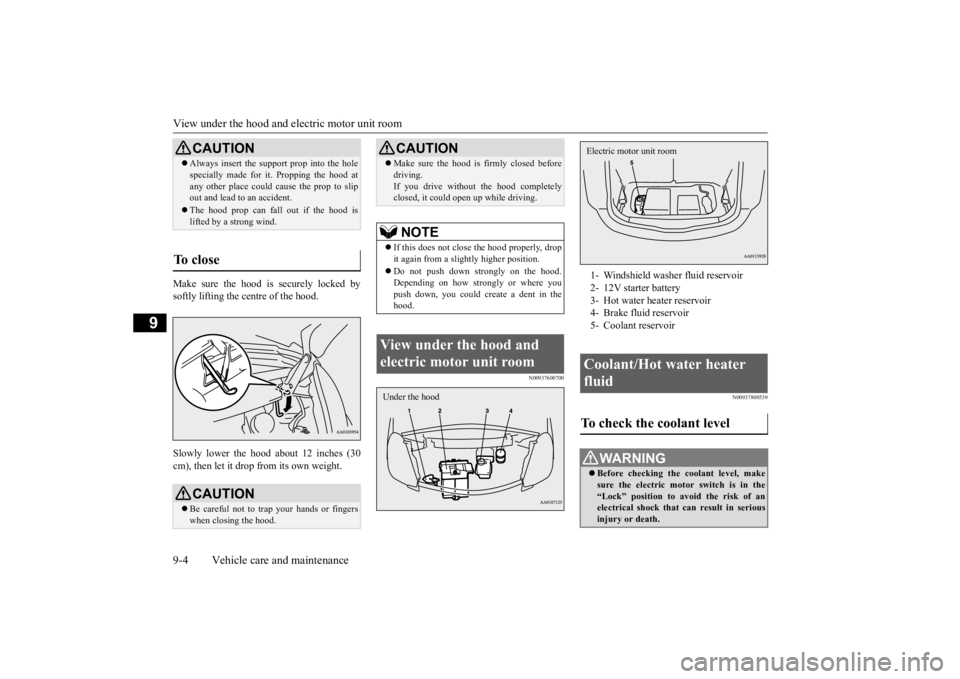
View under the hood and
electric motor unit room
9-4 Vehicle care and maintenance
9
Make sure the hood is securely locked by softly lifting the centre of the hood. Slowly lower the hood about 12 inches (30 cm), then let it drop from its own weight.
N00937600700
N00937800539
CAUTION Always insert the support prop into the hole specially made for
it. Propping the hood at
any other place could
cause the prop to slip
out and lead to
an accident.
The hood prop can fall out if the hood is lifted by a strong wind.
To close
CAUTION Be careful not to trap your hands or fingers when closing the hood.
Make sure the hood is firmly closed before driving.If you drive without the hood completelyclosed, it could open up while driving.NOTE
If this does not close the hood properly, drop it again from a slightly higher position. Do not push down strongly on the hood. Depending on how strongly or where you push down, you could create a dent in the hood.
View under the hood and electric motor unit room
CAUTION
Under the hood
1- Windshield washer fluid reservoir 2- 12V starter battery 3- Hot water heater reservoir 4- Brake fluid reservoir5- Coolant reservoirCoolant/Hot water heater fluid To check the coolant level
WA R N I N G Before checking the
coolant level, make
sure the electric motor switch is in the“Lock” position to
avoid the risk of an
electrical shock that can result in serious injury or death.Electric motor unit room
BK0209800US.book 4 ページ 2014年1月14日 火曜日 午前9時26分
Page 216 of 262
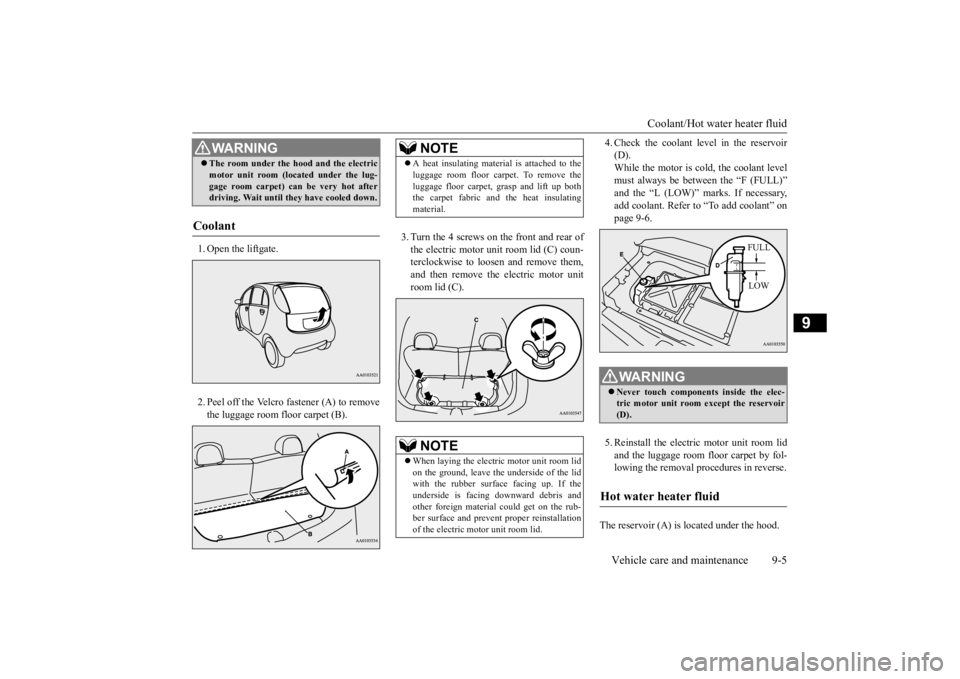
Coolant/Hot water heater fluid
Vehicle care and maintenance 9-5
9
1. Open the liftgate. 2. Peel off the Velcro fastener (A) to remove the luggage room floor carpet (B).
3. Turn the 4 screws on the front and rear of the electric motor unit room lid (C) coun- terclockwise to loosen and remove them,and then remove the electric motor unit room lid (C).
4. Check the coolant level in the reservoir (D).While the motor is cold, the coolant level must always be between the “F (FULL)” and the “L (LOW)”
marks. If necessary,
add coolant. Refer to
“To add coolant” on
page 9-6. 5. Reinstall the electric motor unit room lid and the luggage room floor carpet by fol- lowing the removal procedures in reverse.
The reservoir (A) is located under the hood.
The room under the h
ood and the electric
motor unit room (loc
ated under the lug-
gage room carpet) can be very hot afterdriving. Wait until they have cooled down.
Coolant
WA R N I N G
NOTE
A heat insulating material is attached to the luggage room floor ca
rpet. To remove the
luggage floor carpet, grasp and lift up boththe carpet fabric and the heat insulating material.NOTE
When laying the electric motor unit room lid on the ground, leave the underside of the lid with the rubber surface facing up. If theunderside is facing downward debris and other foreign material
could get on the rub-
ber surface and prevent proper reinstallationof the electric motor unit room lid.
WA R N I N G Never touch components inside the elec- tric motor unit room except the reservoir (D).
Hot water heater fluid
FULL LOW
BK0209800US.book 5 ページ 2014年1月14日 火曜日 午前9時26分
Page 217 of 262
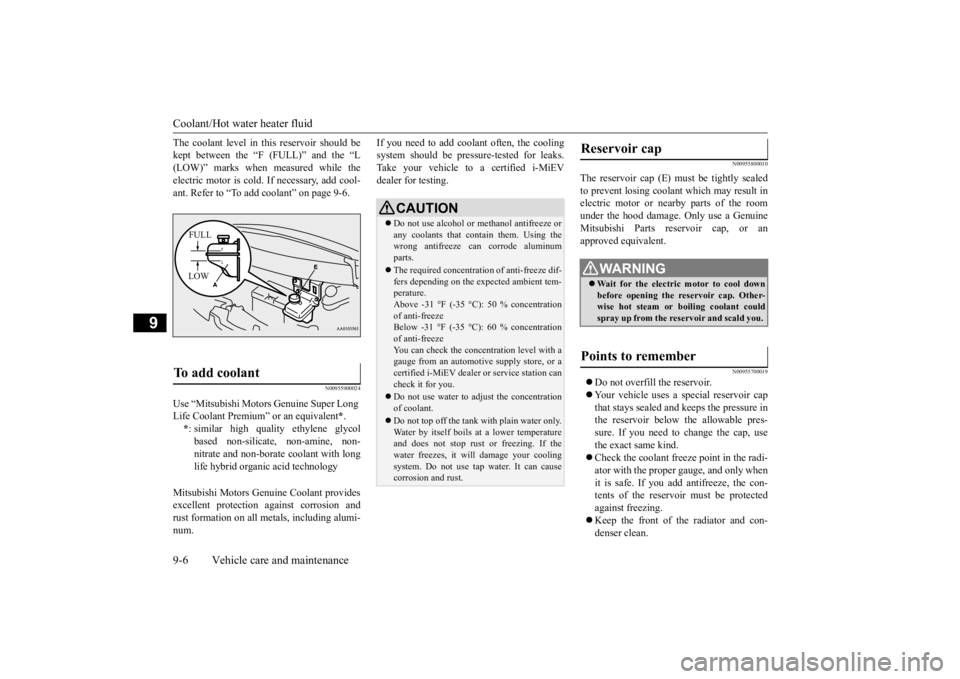
Coolant/Hot water heater fluid 9-6 Vehicle care and maintenance
9
The coolant level in th
is reservoir should be
kept between the “F (FULL)” and the “L(LOW)” marks when measured while the electric motor is cold. If necessary, add cool- ant. Refer to “To add coolant” on page 9-6.
N00955900024
Mitsubishi Motors Genui
ne Coolant provides
excellent protection against corrosion and rust formation on all metals, including alumi- num.
If you need to add coolant often, the cooling system should be pressure-tested for leaks.Take your vehicle to a certified i-MiEV dealer for testing.
N00955800010
The reservoir cap (E) must be tightly sealedto prevent losing coolant which may result in electric motor or nearby parts of the roomunder the hood damage. Only use a Genuine Mitsubishi Parts rese
rvoir cap, or an
approved equivalent.
N00955700019
Do not overfill the reservoir. Your vehicle uses a special reservoir cap that stays sealed and keeps the pressure inthe reservoir below the allowable pres- sure. If you need to change the cap, use the exact same kind. Check the coolant freeze point in the radi- ator with the proper gauge, and only when it is safe. If you add antifreeze, the con-tents of the reservoi
r must be protected
against freezing. Keep the front of the radiator and con- denser clean.
To add coolant Use “Mitsubishi Motors
Genuine Super Long
Life Coolant Premium”
or an equivalent
*.
* : similar high qual
ity ethylene glycol
based non-silicate, non-amine, non-nitrate and non-borate coolant with long life hybrid organic acid technologyFULL LOW
CAUTION Do not use alcohol or
methanol antifreeze or
any coolants that c
ontain them. Using the
wrong antifreeze can corrode aluminumparts. The required concentration of anti-freeze dif- fers depending on the
expected ambient tem-
perature. Above -31 °F (-35 °C):
50 % concentration
of anti-freeze Below -31 °F (-35 °C): 60 % concentration of anti-freezeYou can check the concen
tration level with a
gauge from an automotive supply store, or a certified i-MiEV dealer or service station cancheck it for you. Do not use water to adjust the concentration of coolant. Do not top off the tank with plain water only. Water by itself boils at a lower temperature and does not stop rust or freezing. If the water freezes, it will
damage your cooling
system. Do not use tap water. It can cause corrosion and rust.
Reservoir cap
WA R N I N G Wait for the electric motor to cool down before opening the re
servoir cap. Other-
wise hot steam or bo
iling coolant could
spray up from the re
servoir and scald you.
Points to remember
BK0209800US.book 6 ページ 2014年1月14日 火曜日 午前9時26分
Page 218 of 262
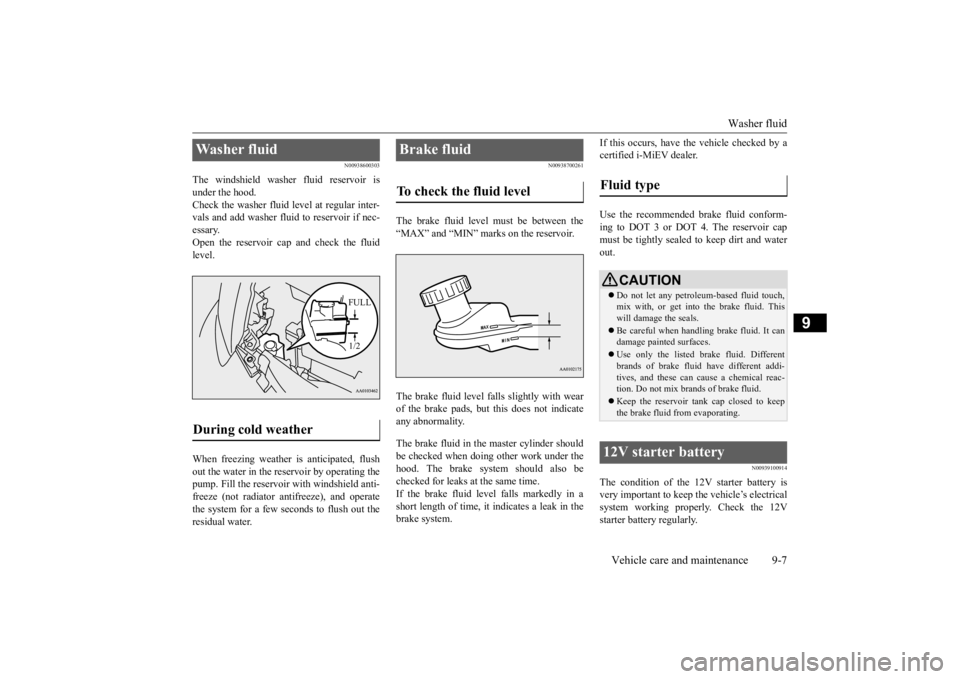
Washer fluid
Vehicle care and maintenance 9-7
9
N00938600303
The windshield washer fluid reservoir is under the hood. Check the washer fluid level at regular inter-vals and add washer fluid to reservoir if nec- essary. Open the reservoir cap and check the fluidlevel. When freezing weather is anticipated, flush out the water in the reservoir by operating the pump. Fill the reservoir with windshield anti-freeze (not radiator
antifreeze), and operate
the system for a few se
conds to flush out the
residual water.
N00938700261
The brake fluid level must be between the “MAX” and “MIN” marks on the reservoir. The brake fluid level fa
lls slightly with wear
of the brake pads, but
this does not indicate
any abnormality. The brake fluid in the master cylinder should be checked when doing other work under the hood. The brake system should also bechecked for leaks at the same time. If the brake fluid level falls markedly in a short length of time, it indicates a leak in thebrake system.
If this occurs, have the vehicle checked by a certified i-MiEV dealer. Use the recommended brake fluid conform- ing to DOT 3 or DOT 4. The reservoir capmust be tightly sealed
to keep dirt and water
out.
N00939100914
The condition of the 12V starter battery is very important to keep the vehicle’s electricalsystem working properly. Check the 12V starter battery regularly.
Washer fluid During cold weather
FULL 1/2
Brake fluid To check the fluid level
Fluid type
CAUTION Do not let any petrol
eum-based fluid touch,
mix with, or get into the brake fluid. This will damage the seals. Be careful when handling brake fluid. It can damage painted surfaces. Use only the listed brake fluid. Different brands of brake fluid have different addi-tives, and these can cause a chemical reac- tion. Do not mix brands of brake fluid. Keep the reservoir ta
nk cap closed to keep
the brake fluid from evaporating.
12V starter battery
BK0209800US.book 7 ページ 2014年1月14日 火曜日 午前9時26分
Page 219 of 262
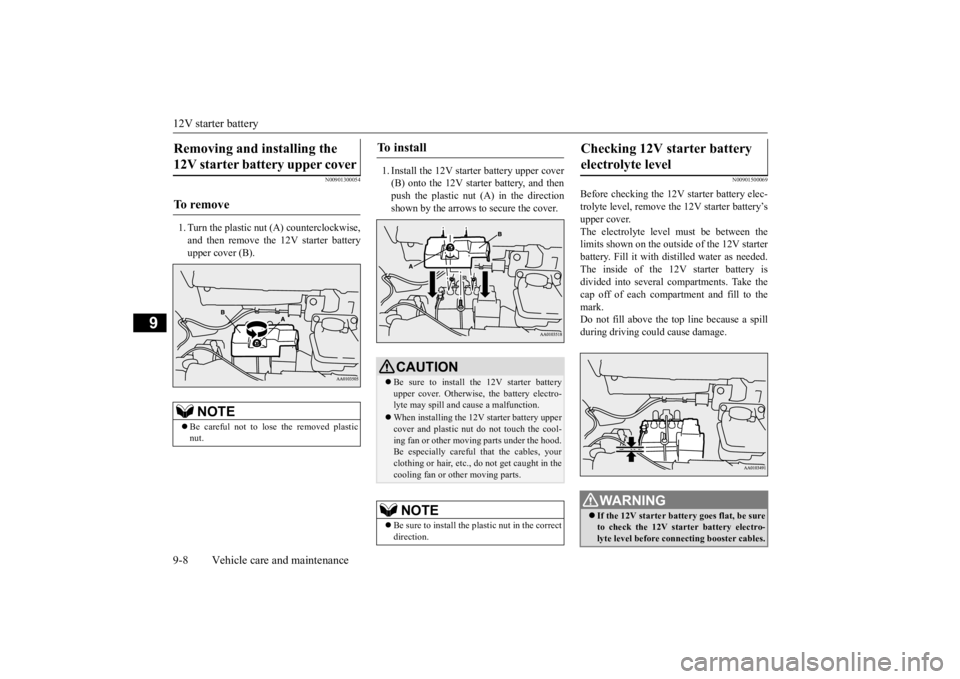
12V starter battery 9-8 Vehicle care and maintenance
9
N00901300054
1. Turn the plastic nut (A) counterclockwise, and then remove the 12V starter battery upper cover (B).
1. Install the 12V starter battery upper cover (B) onto the 12V starter battery, and then push the plastic nut (A) in the direction shown by the arrows to secure the cover.
N00901500069
Before checking the 12V starter battery elec-trolyte level, remove th
e 12V starter battery’s
upper cover. The electrolyte level
must be between the
limits shown on the outside of the 12V starterbattery. Fill it with distilled water as needed. The inside of the 12V starter battery is divided into several compartments. Take the cap off of each compartment and fill to the mark.Do not fill above the t
op line because a spill
during driving could cause damage.
Removing and installing the 12V starter battery upper cover To r e m o v e
NOTE
Be careful not to lose the removed plastic nut.
To install
CAUTION Be sure to install the 12V starter battery upper cover. Otherwise,
the battery electro-
lyte may spill and
cause a malfunction.
When installing the 12V
starter battery upper
cover and plastic nut
do not touch the cool-
ing fan or other moving parts under the hood.Be especially carefu
l that the cables, your
clothing or hair, etc.,
do not get caught in the
cooling fan or ot
her moving parts.
NOTE
Be sure to install the plastic nut in the correct direction.
Checking 12V starter battery electrolyte level
WA R N I N G If the 12V starter battery goes flat, be sure to check the 12V star
ter battery electro-
lyte level before connecting booster cables.
BK0209800US.book 8 ページ 2014年1月14日 火曜日 午前9時26分
Page 220 of 262
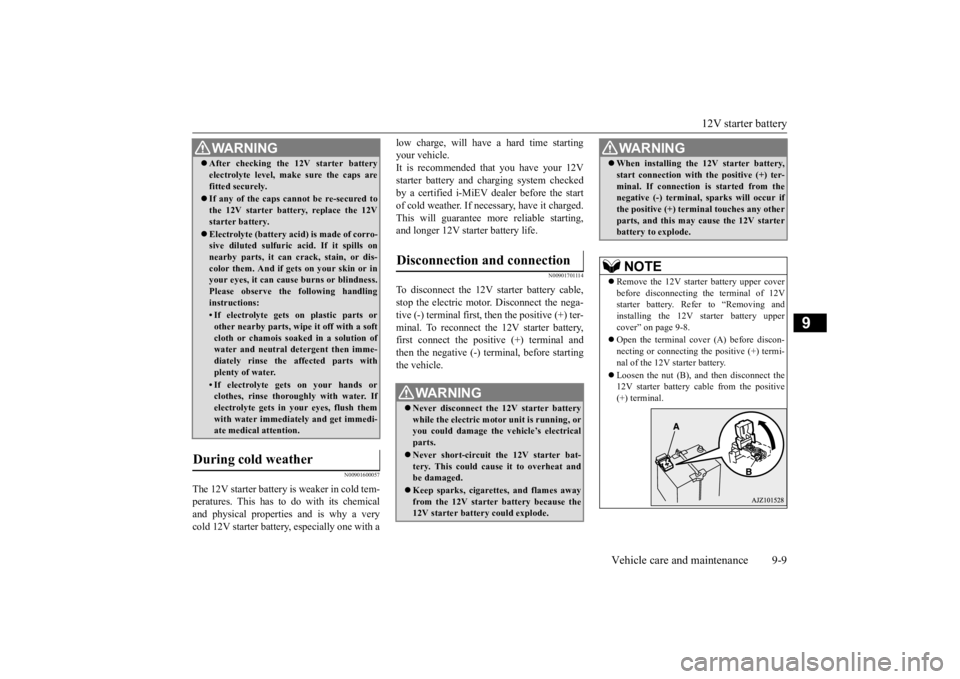
12V starter battery
Vehicle care and maintenance 9-9
9
N00901600057
The 12V starter battery is weaker in cold tem- peratures. This has to do with its chemicaland physical propertie
s and is why a very
cold 12V starter battery, especially one with a
low charge, will have a hard time starting your vehicle.It is recommended that you have your 12V starter battery and charging system checked by a certified i-MiEV dealer before the startof cold weather. If necessary, have it charged. This will guarantee more reliable starting, and longer 12V starter battery life.
N00901701114
To disconnect the 12V starter battery cable,stop the electric motor.
Disconnect the nega-
tive (-) terminal first, then the positive (+) ter- minal. To reconnect th
e 12V starter battery,
first connect the positi
ve (+) terminal and
then the negative (-) terminal, before starting the vehicle.
After checking the 12V starter battery electrolyte level, make sure the caps arefitted securely. If any of the caps cannot be re-secured to the 12V starter battery, replace the 12Vstarter battery. Electrolyte (battery acid) is made of corro- sive diluted sulfuric acid. If it spills on nearby parts, it can crack, stain, or dis- color them. And if gets on your skin or inyour eyes, it can cause burns or blindness. Please observe the following handling instructions:• If electrolyte gets on plastic parts orother nearby parts, wi
pe it off with a soft
cloth or chamois soak
ed in a solution of
water and neutral detergent then imme- diately rinse the affected parts withplenty of water.• If electrolyte gets on your hands orclothes, rinse thoroughly with water. If electrolyte gets in your eyes, flush them with water immediat
ely and get immedi-
ate medical attention.
During cold weather
WA R N I N G
Disconnection and connection
WA R N I N G Never disconnect the
12V starter battery
while the electric motor unit is running, or you could damage the
vehicle’s electrical
parts. Never short-circuit
the 12V starter bat-
tery. This could cause it to overheat and be damaged. Keep sparks, cigarette
s, and flames away
from the 12V starter battery because the 12V starter battery could explode.
When installing the
12V starter battery,
start connection with the positive (+) ter-minal. If connection is started from thenegative (-) terminal,
sparks will occur if
the positive (+) termin
al touches any other
parts, and this may cause the 12V starterbattery to explode.NOTE
Remove the 12V starte
r battery upper cover
before disconnecting the terminal of 12V starter battery. Refer to “Removing and installing the 12V st
arter battery upper
cover” on page 9-8. Open the terminal cover (A) before discon- necting or connecting the positive (+) termi- nal of the 12V
starter battery.
Loosen the nut (B), and then disconnect the 12V starter batt
ery cable from the positive
(+) terminal.WA R N I N G
BK0209800US.book 9 ページ 2014年1月14日 火曜日 午前9時26分